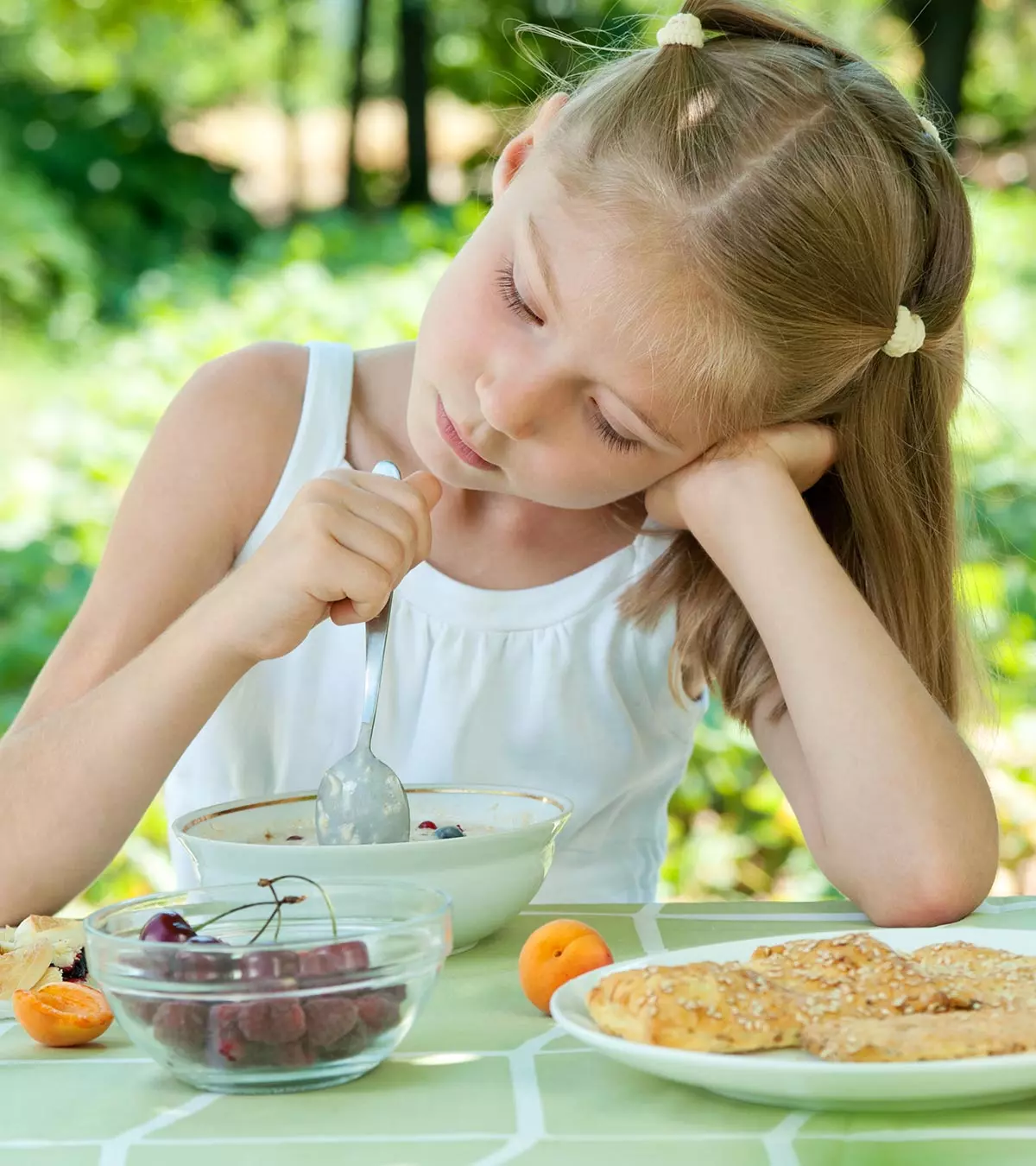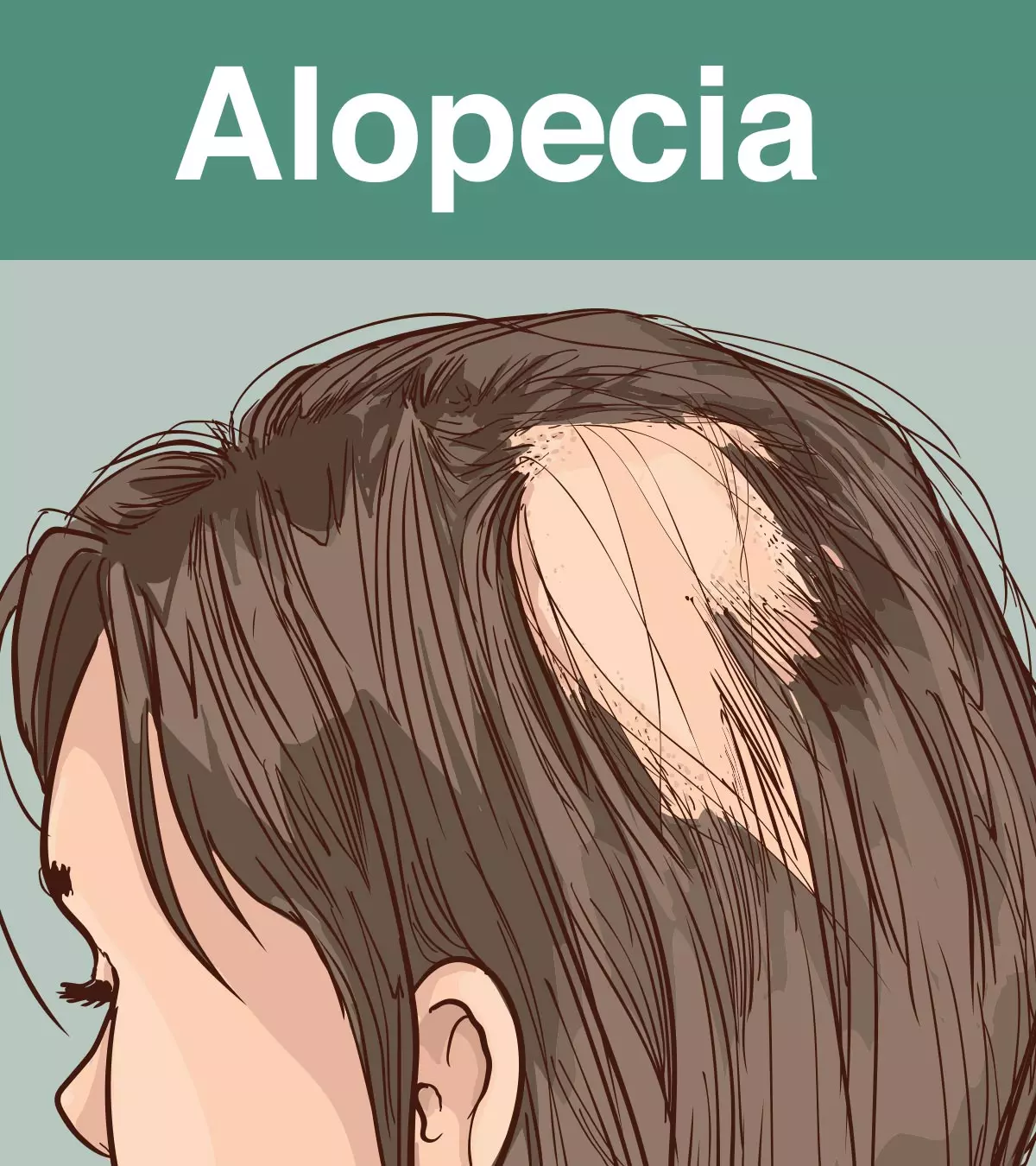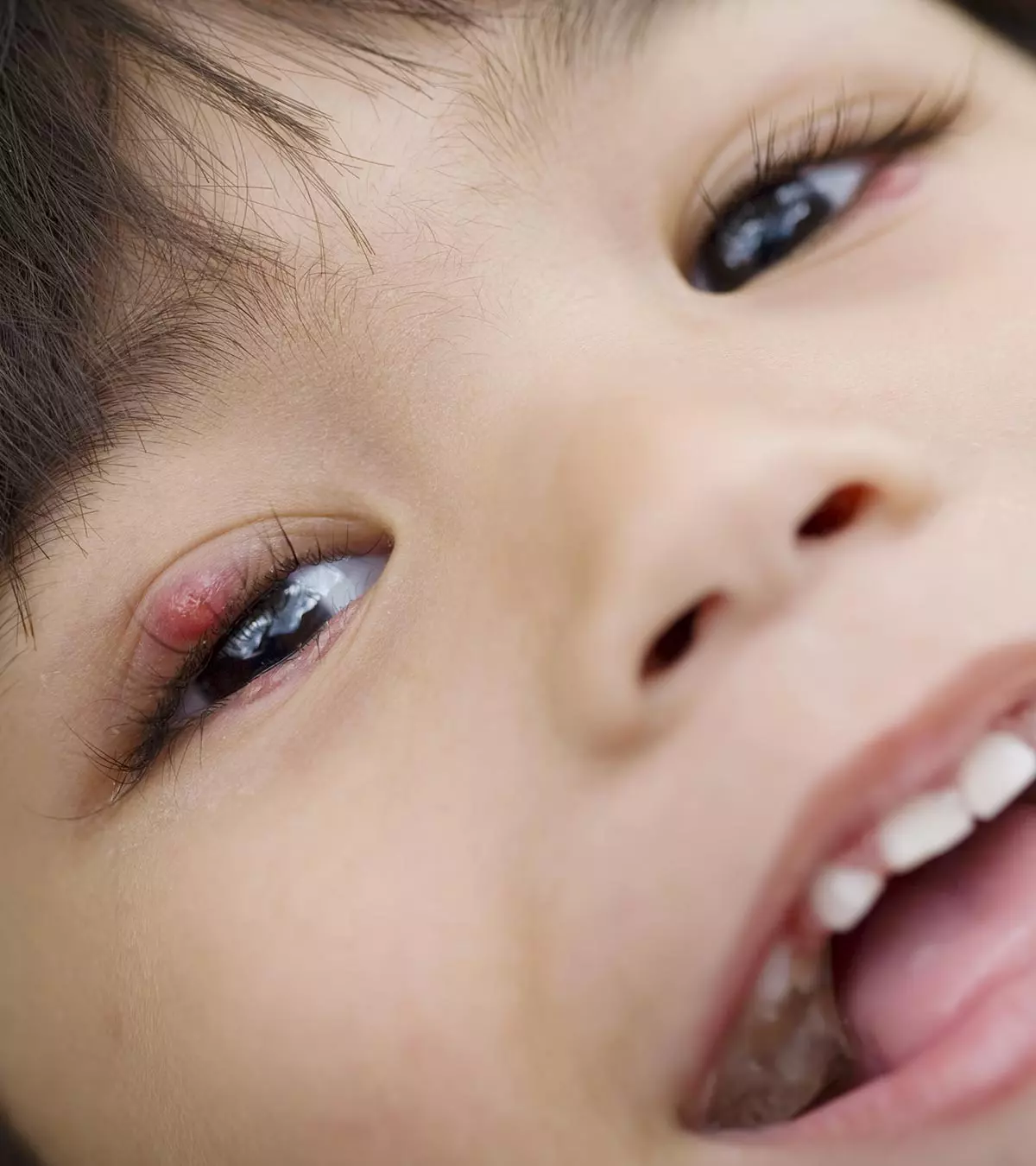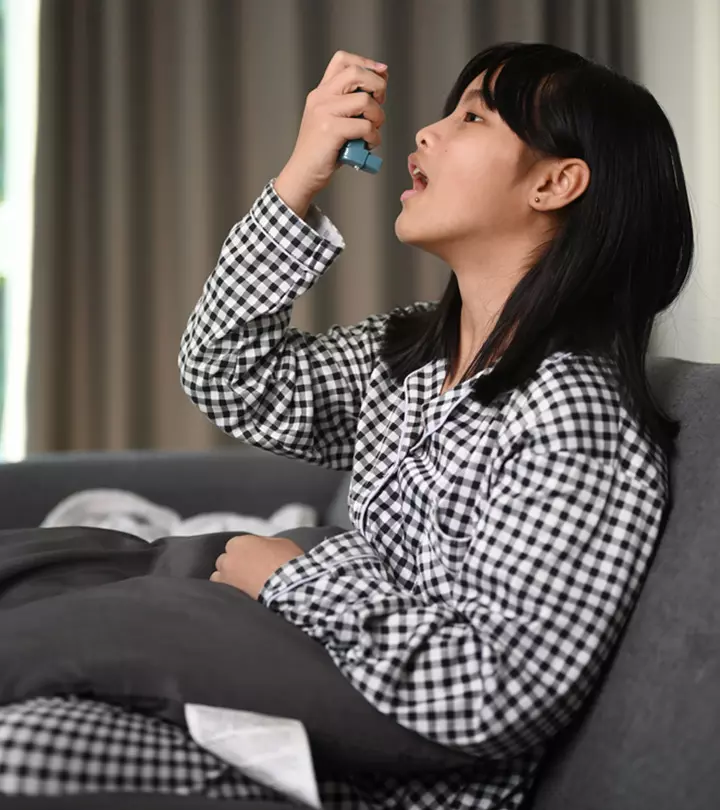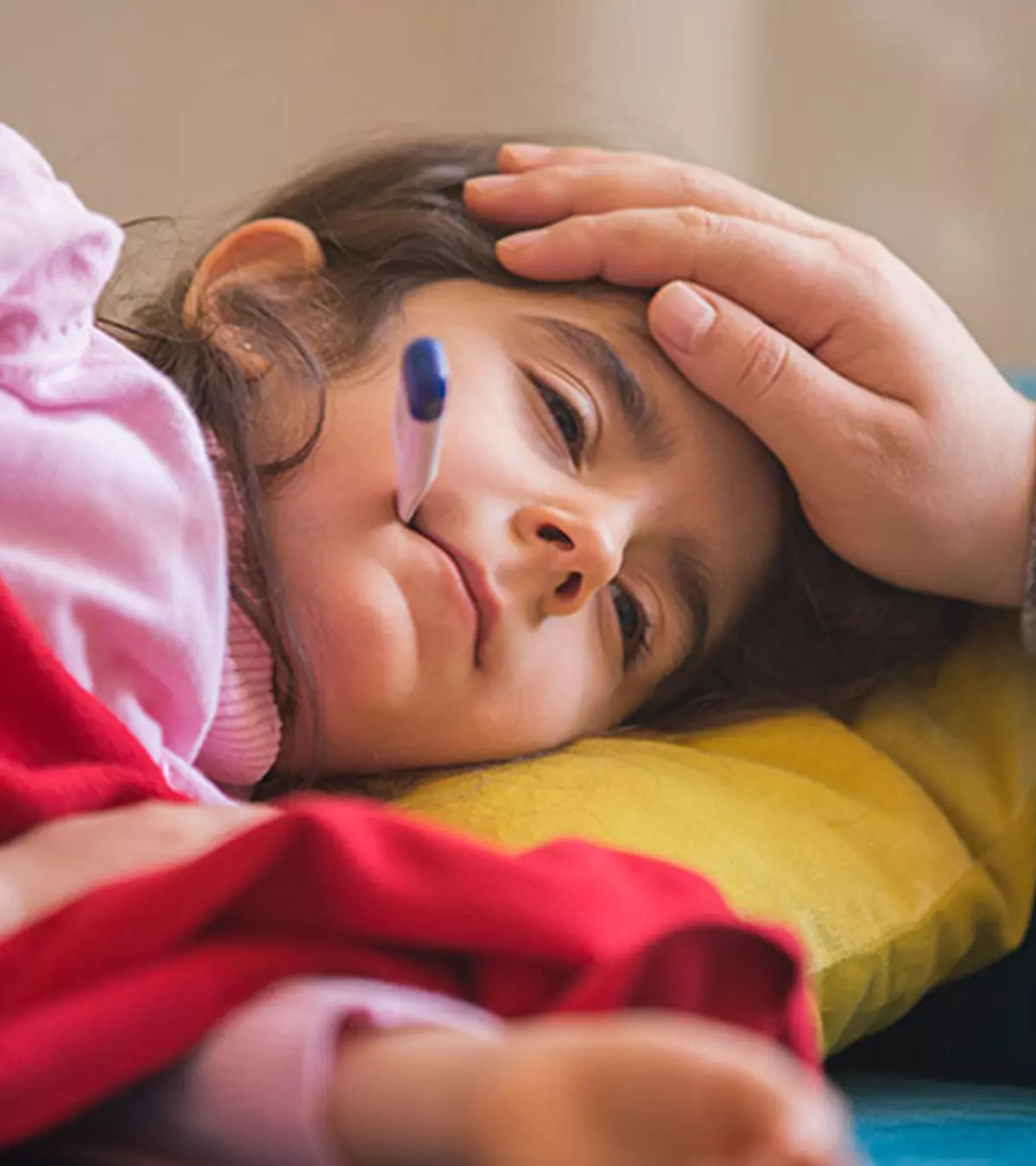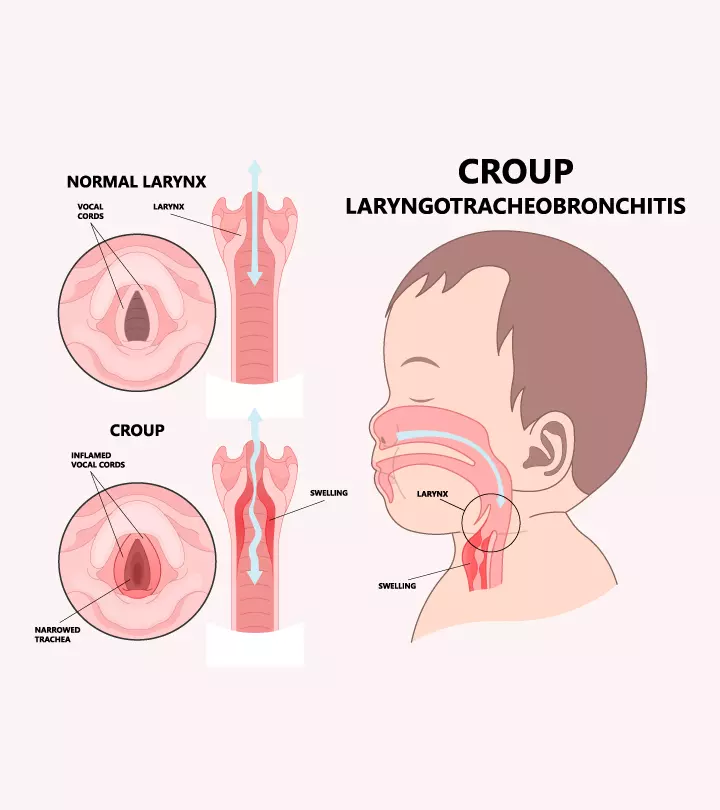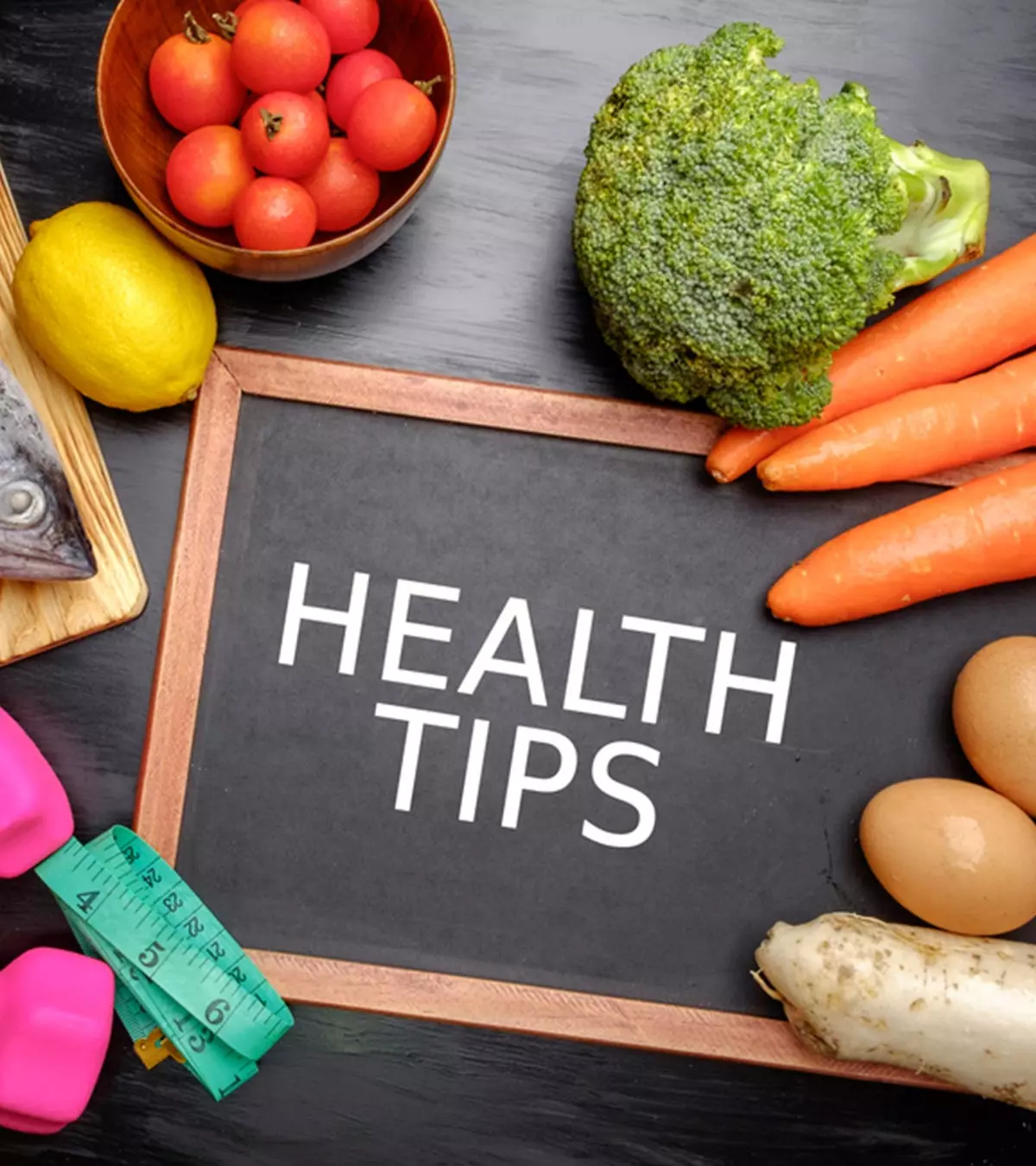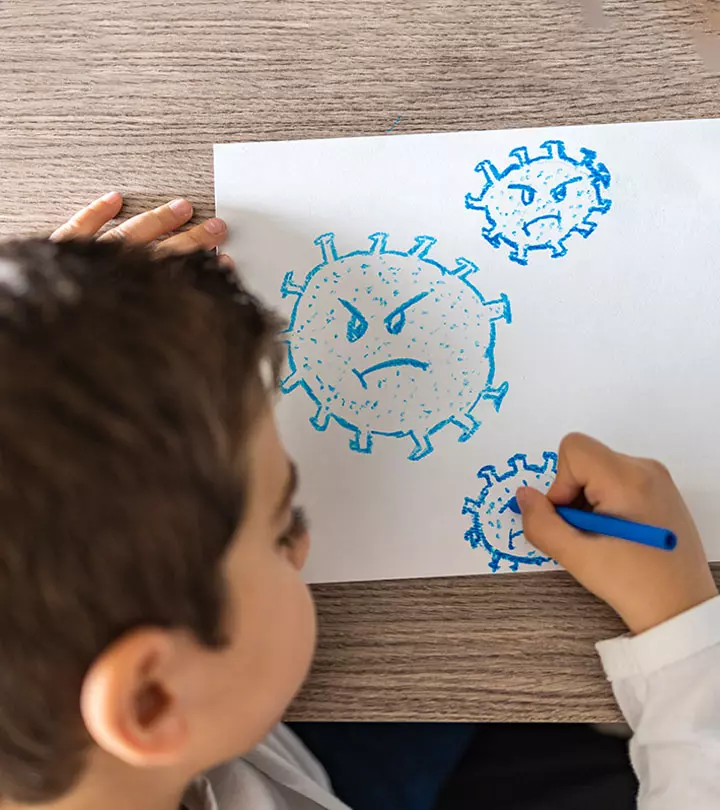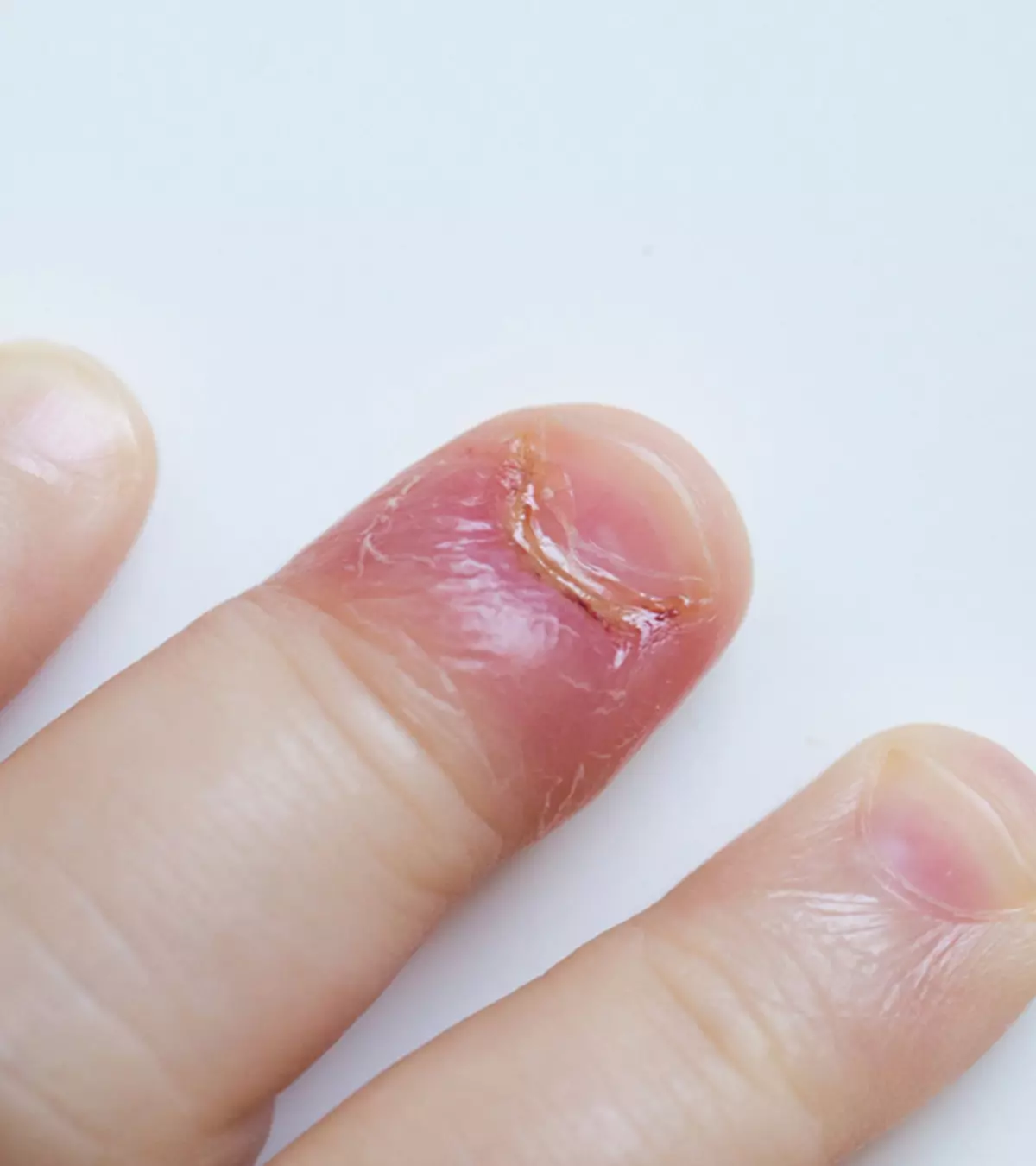
Image: Shutterstock
Mumps in children is a viral infection affecting the salivary glands. Though children are usually vaccinated against the infection as a part of their mandatory vaccine roster, it is important to take preventive measures against it. The mumps virus is highly contagious, and children most commonly pick up the virus from schools and daycare centers. So what to do to ensure your child is protected from it? Read on to know more about the symptoms, causes, diagnosis, and treatment for mumps in kids.
Key Pointers
- Mumps is a viral infection of the parotid glands caused by the mumps virus.
- The mumps virus can be contracted by children through shared utensils, touching infected surfaces, or inhaling contaminated saliva or mucus.
- Children with mumps may experience fever, muscle pains, headaches, lethargy, swollen salivary glands, and loss of appetite.
- Mumps typically lasts for a week or two but can disappear in as little as a few days.
- To protect children from contracting mumps, vaccination should be taken, and good hygiene and habits should be followed.
What Is Mumps?
Mumps is an infection of the salivary glands by the mumps virus
. The virus usually affects the largest salivary gland called the parotid gland. There is one parotid gland in front of each ear, under the skin. Since mumps affects the parotid gland, the disease is also called infectious parotitis (1) (2). It can also affect other organs that will be discussed shortly.
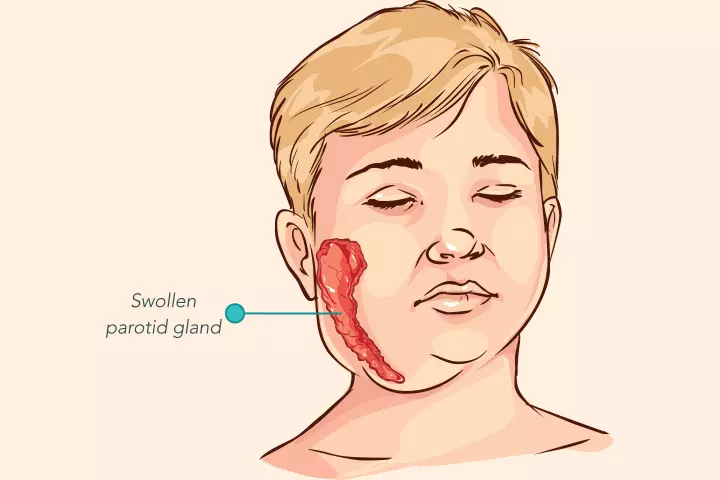
What Causes Mumps In Children?
A child can catch the mumps virus (called Rubulavirus from the family Paramyxovirus) under the below circumstances:
- By coming in contact with the saliva or mucus droplets expelled by an infected person while sneezing or coughing.
- Using or sharing the utensils with an infected person.
- Touching the surface contaminated by the virus (for instance, when someone with mumps does not wash hands after sneezing and contaminates things that they touch).
The mumps virus can be transmitted even before the salivary glands begin to swell (3).
 Quick fact
Quick factHow Common Is Mumps In Kids?
AlAlmost every person in the US has gotten mumps at least once in their childhood. But the cases of mumps have come down by more than 99% since the introduction of the vaccine in the country (4), according to the US Department of Health and Human Services (HHS).
Vaccination has made mumps less common now than before, but precautions are still essential. Children who have not got all the doses of the vaccine could be vulnerable to the disease. It mostly occurs among children between the age of five and nine years, but older children too can catch the virus (5).
What Are The Symptoms Of Mumps?
A child with mumps will display the following symptoms (6):
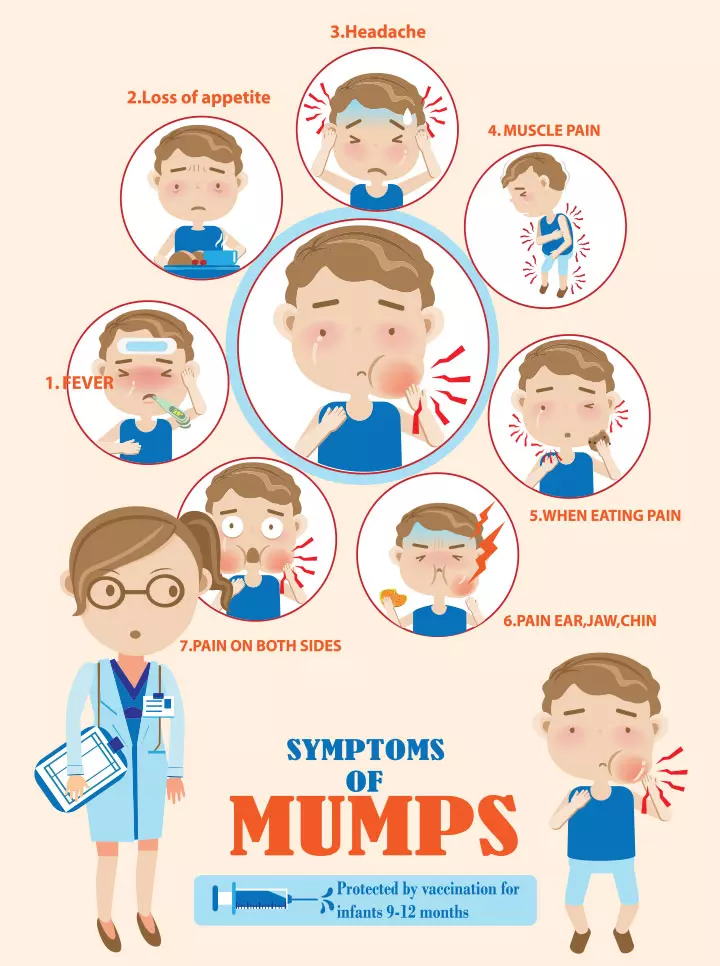
- Fever: The first symptom is fever. It usually lasts for three to four days.
- Muscle ache, headache, and fatigue: The child will complain of lethargy and acute muscle pain across the body. Do note these symptoms are generic and not exclusive to mumps.
- Swelling of the salivary glands: Swelling begins as a small bump below the ear. More fluid gradually accumulates under the skin, causing the swelling to progress to the lower jaw. The cheek swells and may cause the ear to protrude. It may peak 1-3 days after its appearance. Swelling in one parotid gland is common while the other salivary glands present under the tongue and the floor of the mouth may also swell. It is accompanied by earache, pain in the jaws, and tenderness.
- Loss of appetite: The child loses their appetite. Painful and swollen glands (salivary glands) also make it hard for the child to eat anything.
Reflecting on her childhood experience with mumps, blogger Suzanne Bubnash notes, “As a child, I suffered from chickenpox and measles and mumps. Measles and chickenpox made me ill and miserable with itching and kept me out of school. Mumps took first place on the misery index. The pain in my glands was so acutely intense that when I concentrate on that memory, I can remember where in the house my sickbed was and how I cried from the agony. Tears revisit my eyes, recollecting the torturous pain (i).”
The first symptoms of the disease usually appear 16-18 days after contracting the virus. Early recognition is crucial for proper treatment. The swollen salivary gland makes the disease evident, and you need to consult a doctor.
How Is Mumps In Children Diagnosed?
The diagnosis of mumps involves three steps (7):
- Physical examination: The doctor checks the swelling to distinguish it from swollen lymph nodes. Mumps swelling does not have a clear border unlike swollen lymph nodes. Also, swollen lymph nodes are present behind the jaw whereas the parotid gland is present on the side of the face, below the ear.
- Mucus and sputum test: Nasal and mouth swabs determine the presence of the virus in the mucus and saliva.
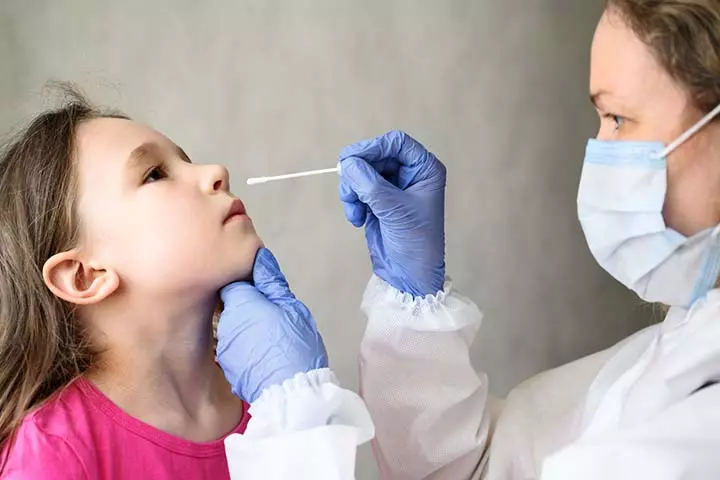
- Blood test: Blood test checks for the presence of antibodies against the mumps virus. It also helps determine if the virus has spread to the other parts of the body through blood.
These tests help to confirm the presence of mumps.
Does Mumps Have Treatment?
There is no treatment for mumps (8). You will have to wait for the immune system to work on the virus. However, your child’s doctor may prescribe medication to ease symptoms.
How Long Does Mumps Last In Children?
Mumps usually lasts about a week or two but may resolve within a few days. The duration varies depending on factors like the age of the child, overall health, and whether they have been vaccinated.
Vaccinated children who get the disease will have a shorter run of mumps and display mild symptoms.
Since there is no medicine for the disease, home care is the best way to make the child feel better.
How To Take Care Of The Child During Mumps?
You can take the below measures to make a child with mumps feel better (10):
- Let them take rest: Just like in any other viral illness, the body requires rest to fight the mumps infection. Do not send the child to school and let them have bed rest. The child should avoid playing, running, and other hectic activities.
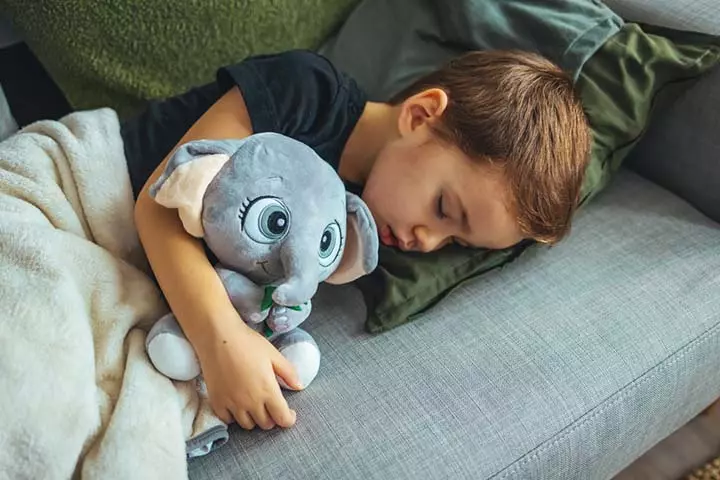
- Give more fluids: Make the child drink lots of water. The swelling on the jaw makes eating difficult. So increase the liquid content in the child’s diet. Give them foods like pureed fruit, meat, and vegetable broth.
- Administer acetaminophen or ibuprofen: You may give a dose of acetaminophen (paracetamol) or ibuprofen to the child. However, it is good to consult a doctor before giving the medicine, especially if the child is very young, has some other illness, or is on another medication.
Home care and attention to the child is essential to help them feel better. But sometimes, the mumps virus may lead to health complications.
 Quick tip
Quick tipWhat Are The Complications Of Mumps in Kids?
Mumps may occasionally cause the following complications (11):
- Meningitis: It is the infection and inflammation of meninges, the tissue covering the brain and the spinal cord. Meningitis in children is generally treatable, and most children who get this complication recover completely.
- Encephalitis: It is the inflammation of the brain. Most children recover from it. However, it can lead to severe neurological symptoms.
- Orchitis: Painful inflammation of one or both the testicles. It only occurs in boys who have attained puberty. About 50% of cases report a shrinkage in testis size and 1 in 10 males will develop a drop in sperm count. Infertility due to mumps-induced orchitis is rare.
- Oophoritis and mastitis: Oophoritis is painful inflammation of ovaries and mastitis is swelling of the breast tissue. It will only occur in girls who have attained puberty.
- Pancreatitis: Painful inflammation of the pancreas. Symptoms may include fever, and upset stomach.
- Deafness: The deafness can be temporary or permanent.
The complications are more common in adults than in children. You may avoid these problems by preventing the infection.
How To Prevent Mumps In Children?
You may take these measures for the prevention of mumps in children:
- Vaccinate: Mumps is a viral infection in children that can lead to complications, making vaccination essential for prevention. The vaccine has been found to significantly reduce the number of cases and make mumps nearly non-existent in several communities. The Centers for Disease Control and Prevention highlights that all children should receive the first dose of MMR vaccine between the ages of 12 and 15 months and the second dose between the ages of 4 and 6 years. Two doses of the MMR vaccine provide an 88% efficacy rate against mumps.
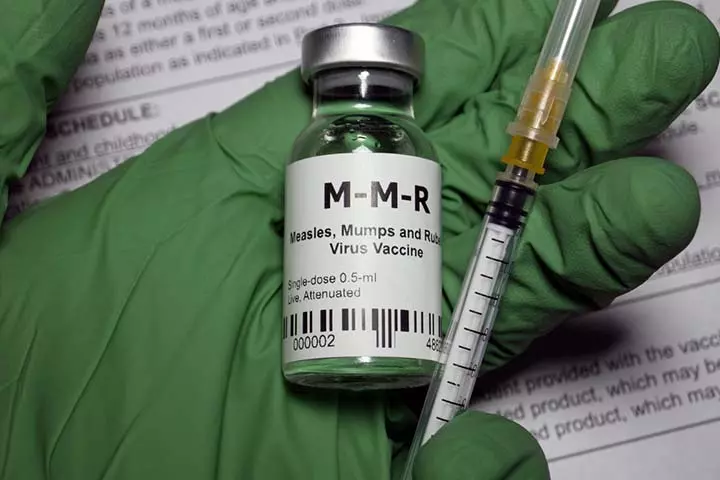
- Good hygiene: Teach your child to wash their hands with soap after they come from play. If they come in contact with an object used by someone with a fever, then, too, they must wash their hands. Maintaining hygiene mitigates the spread of the virus.
- Good habits: Tell your children not to share a glass or spoon with someone who is unwell. Also, explain to them the need to cover their mouth and nose while sneezing or coughing. If someone around them sneezes or coughs without covering their mouth/nose, then the child should cover their nose and mouth with a handkerchief to avoid inhalation of droplets of saliva and mucus.
The above steps help control the spread of the virus. However, immunization is the best way to prevent mumps. Next, we answer questions about the mumps vaccine.
Frequently Asked Questions
1. What vaccine should my child have against mumps?
Mumps vaccine is a part of the MMR (measles, mumps, and rubella) vaccine. The combination vaccine protects against the three diseases. A newer vaccine, MMRV (measles, mumps, rubella, and varicella), is also available; it works against the chickenpox virus (varicella) in addition to the MMR diseases. The schedule of the MMRV vaccine could slightly vary from that of the MMR vaccine. You may consult your doctor on this.
2. When should my child have the mumps vaccine?
Your child needs two doses of MMR vaccine — the first dose during 12-15 months, and the second during 4-6 years. Both the doses are critical for immunity. Missing the second dose will not provide adequate protection against the virus.
3. Are there any side effects of the mumps vaccine?
Some of the common side effects are soreness, swelling or mild pain at the site of injection and fever. Temporary pain in the joints might occur if the second dose is given during the teenage. Serious side effects are rare. The MMR vaccine is authorized and declared safe by multiple childcare organizations around the world including UNICEF. It may also cause other side effects such as joint stiffness, arm soreness, or rash (12). (13).
4. Can mumps vaccine cause autism?
No. There is no scientific evidence to show that the mumps vaccine causes autism. The US Centers for Disease Control and Prevention states that scientists across the world have studied the MMR vaccine, and none has found a link between the vaccine and autism (14).
5. When should I not give the mumps vaccine to my child?
Do not give the MMR vaccine in the below circumstances (4):
- Allergic reaction to the first shot. In such a case, the child should not get the second booster shot.
- Children with HIV/AIDS.
- Children on immunosuppressive medication.
- Those with cancer or undergoing treatment of cancer.
- Have a constant low platelet count due to a medical disorder.
- Children who recently had a blood transfusion or were given blood plasma.
- Children who had another vaccine in the past month.
Your doctor will assess the child’s health and tell you whether or not you should give the vaccine to your child.
6. Can my child get mumps even after immunization?
Probably, but the chances are very few. Vaccines are made to protect against most cases of exposure and not all. A child will require prolonged close contact with an infected person to get mumps after two doses of MMR vaccine (15). But it is still safe to have a vaccine than leave the child vulnerable without it.
Also, those who get mumps even after two doses of the vaccine experience significantly less severe symptoms, recover faster and are less likely to develop complications.
7. Is ice cream good for mumps?
Foods such as ice cream do not require chewing and may help soothe the sore glands that occur in a mumps infection (16).
8. Can a child go to school with mumps?
Children with mumps should avoid contact with other people until five days after their salivary glands begin to swell, as they are contagious during this time. They should not attend school or any social events (16).
9. Can antibiotics cure mumps?
Mumps occurs due to a viral infection, so it can’t be treated with antibiotics as they work only against bacterial infections (1).
Direct contact with the saliva of an infected person while coughing or sneezing, sharing personal items or utensils, and touching the contaminated surfaces can cause mumps in children. Vaccination helps to reduce the incidence of mumps in children compared to the past. Fever, muscle aches, headache, swelling of salivary glands, and loss of appetite are common symptoms and signs of mumps. Physical examination and sputum test help diagnose mumps. However, there is no need for specific treatment since it can be self-resolving within a few days of supportive care.
Infographic: How To Care For A Child With Mumps
Mumps can be painful, causing your child to lose their appetite and experience other symptoms. However, this viral infection can be prevented despite being common. Additionally, some care can ease the symptoms and help your child heal. Check out the infographic below to know more.

Illustration: Momjunction Design Team
Illustration: Mumps In Children - Causes Symptoms And Home Care

Image: Dall·E/MomJunction Design Team
Mumps is a contagious viral infection affecting the salivary glands. This informative video provides valuable insights into its causes, signs, diagnosis, and treatment.
Personal Experience: Source
MomJunction articles include first-hand experiences to provide you with better insights through real-life narratives. Here are the sources of personal accounts referenced in this article.
i. The miracle of vaccinations.https://topomountain.blogspot.com/2014/11/the-miracle-of-vaccinations.html
References
- Mumps, Nemours Kids Health
https://kidshealth.org/en/parents/mumps.html - Mumps Symptoms and Complications; Centers for Disease Control and Prevention
https://www.cdc.gov/mumps/signs-symptoms/?CDC_AAref_Val=https://www.cdc.gov/mumps/about/signs-symptoms.html - Mumps: Questions and Answers, Government of Newfoundland and Labrador
https://www.health.gov.nl.ca/health/publichealth/cdc/infectioncontrol/Mumps_Jan_2018.pdf - Mumps, U.S. Department of Health and Human Services
https://www.hhs.gov/immunization/diseases/mumps/index.html - Mumps
https://www.who.int/teams/health-product-policy-and-standards/standards-and-specifications/norms-and-standards/vaccine-standardization/mumps - About Mumps
https://www.cdc.gov/mumps/about/index.html#:~:text=Mumps%20is%20a%20contagious%20viral,vaccine%2C%20especially%20before%20travelling%20internationally. - Measles and Mumps, Tests U.S. National Library of Medicine
https://medlineplus.gov/lab-tests/measles-and-mumps-tests/ - Mumps, Cleveland Clinic
https://my.clevelandclinic.org/health/diseases/15007-mumps - Mumps, Missouri Department of Health & Senior Services
https://health.mo.gov/living/healthcondiseases/communicable/mumps/index.php - Mumps, Connecticut Department of Public Health
https://portal.ct.gov/-/media/departments-and-agencies/dph/dph/infectious_diseases/abcs/ridrmjuly2009vaccinepreventpdf.pdf?la=en - Mumps, McKinley Health Center
https://mckinley.illinois.edu/sites/default/files/docs/mumps.pdf - Measles explained: What’s behind the recent outbreaks?; UNICEF, UNICEF
https://www.unicef.org/stories/measles-cases-spiking-globally - Measles, Mumps, Rubella (MMR) Vaccine Safety
https://www.cdc.gov/vaccine-safety/vaccines/mmr.html?CDC_AAref_Val=https://www.cdc.gov/vaccinesafety/vaccines/mmr-vaccine.html - Autism and Vaccines
https://www.cdc.gov/vaccine-safety/about/autism.html?CDC_AAref_Val=https://www.cdc.gov/vaccinesafety/concerns/autism.html - What is the mumps?
https://www.childrenshospital.org/conditions/mumps
- Mumps
https://www.choa.org/~/media/files/Childrens/medical-professionals/nursing-resources/mumps.pdf?la=en
- Mumps, Nemours Kids Health
Community Experiences
Join the conversation and become a part of our nurturing community! Share your stories, experiences, and insights to connect with fellow parents.
Read full bio of Dr. Elna Gibson
Read full bio of Dr. Ritika Shah
Read full bio of Swati Patwal
Read full bio of Ghazia Shah





